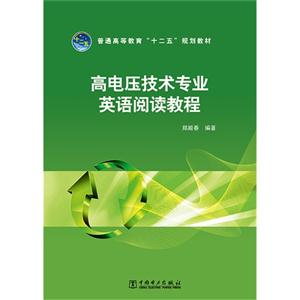Unit 1 Gas Discharge Phenomena 1.1 Classification of Discharges 1.2 Current-voltage Characteristics of DC Discharge1.2.l Non-self-sustaining Discharge1.2.2 Townsend Discharge1.2.3 Glow Discharge1.2.4 Transition to Arc Discharge 1.3 Townsend Breakdown 1.4 Production and Loss of Charges in a GasUnit 2 Non-Destructive High-voltage Tests 2.1 Loss in a Dielectric 2.2 Measurement of the Conduction Current for Direct Voltage 2.3 Measurement of the Dissipation Factor for Alternating Voltage2.3.1 Dielectric Loss and Equivalent Circuits2.3.2 Measurement with the Sobering Bridge 2.4 Measurement of Partial Discharges at Alternating Volfages2.4.1 External Partial Discharges2.4.2 Internal Partial DischargesUnit 3 Liquid and Composite Dielectrics 3.1 Liquid Characteristics 3.2 Solid Dielectrics 3.3 Composites 3.4 Estimation ancl Control of Electrical 3.5 Electric Fields 3.6 Uniformanci Non-Uniform Electric Fielcis 3.7 Estimation of Electric Field in Some Geometric Boundaries3.7.1 Parallel Plates3.7.2 Concentric Cylinders3.7.3 Parallel Cylinders of Equal Diameter 3.8 Surge Voltages, Their Distribution Anti ControlUnit 4 Breakdown in Air Gaps with Solid Insulating Barrier under Impulse Voltage Stress 4.1 Introduction 4.2 The First Approach for the Understanding of the Barrier Effect 4.3 Barriers with Opening 4.4 In Depth Investigation of the Breakdown Process 4.5 Quantitative Analysis of Spaces Charges 4.6 Flashover Around the Barrier without Penetration 4.7 Barrier Effect in Symmetric Fields 4.8 Investigations with Other Types of Voltages 4.9 ConclusionsUnit 5 Specialized Knowledge of Cables 5.1 Material Technology 5.2 Conductor and Insulation Screens 5.3 Cable Design 5.4 Manufacturing 5.5 Installation Design 5.6 Joints/Terminations 5.7 Minute Step Voltage TestUnit 6 Treeing Phenomena of XLPE Cable 6.1 Introcluction 6.2 Failures ofXLPE Cable6.3 Treeing Phenomena in XLPE Cables6.4 Electrical Trees and Mechanisms6.5 Water Treesand MechanismsUnit 7 Specialized Knowledge of Power Transformers 7.1 Features 7.2 Core 7.3 Winding7.3.1 Hisercap Disk Winding (Interleaved Disk Winding)7.3.2 Continuous Disk Winding7.3.3 Helical Coil 7.4 Insulation Structure 7.5 Prevention of Internal Partial Discharge and Insulation7.5.1 Treatment7.5.2 Drying/Oil Filling Treatment7.5.3 Removing Voids7.5.4 Electric Field Control7.5.5 Dust Control 7.6 Measures against Leakage Flux 7.7 Tank 7.8 Cooling System7.8.l Self-cooled Type7.8.2 Air-cooled-air-cooled7.8.3 Forced-oil, Forced-air-cooled Type7.8.4 Forced-oil, Water-cooled Type 7.9 Accessories7.9.1 Oil Preservation System7.9.2 Diaphragm-type Oil Preservation System (Type OH-D)7.9.3 Dehydrating Breather (Types FG, FP, FS)7.9.4 Dial Oil Level Indicator7.9.5 Protective Relays7.9.6 Buchholtz Relay7.9.7 Liquid Temperature Indicator7.9.8 Winding Temperature Indicator Relay7.9.9 Pressure Relief Device 7.10 Low-noise Transformer 7.11 Construction of Cable Connection and GIS7.11.1 Connection Cable Connection7.11.2 GIS (Gas Insulated Switchgear) Connection7.11.3 TransportationUnit 8 Investigation of Sub-Nanosecond Breakdown through Computational Methods, 8.1 Introduction 8.2 Background Theory and Prior Research8.2.1 Background Discharge Regimes in Pulsed Breakdown8.2.2 Townsend Regime8.2.3 Streamer Regime8.2.4 Post Streamer Regime 8.3 Physical Processes in Picosecond Breakdown8.3.1 Field Emission8.3.2 Electron-Neutral Collisions8.3.3 Runaway Electrons8.3.4 Explosive Electron Emission 8.4 Recent Research EffortsUnit 9 Numerical Simulation of Gas Discharge 9.1 Governing Equations9.1.1 Two-Fluid Theory9.1.2 Coefficients9.1.3 Boundary Conditions 9.2 Model Eauations in Dimensionless Form9.2.1 Numerical Approach and Results9.2.2 Grid and Discretization9.2.3 8-Method9.2.4 Time Step and Iteration9.2.5 Boundary Conditions and Error 9.3 One Dimensional Model9.3.1 Thomas Algorithm and Results9.3.2 Two Dimensional Model9.3.3 Successive Over Relaxation Method9.3.4 Results9.3.5 Convergence 9.4 Dynamic Characteristics of SF6-N2-CO2 Gas Mixtures in DC Discharge Process9.4.1 The Hybrid Computing Model9.4.2 Development of the Avalanche and Streamer9.4.3 Spatial Electric Field and Electron Velocity9.4.4 Influence of PhotoionizationUnit 10 Pattern Dynamics in a Two-dimensional Gas Discharge System 10.1 Introduction 10.2 Experiment 10.3 Model10.3.1 Assumption10.3.2 Specific Model10.3.3 Constraint for the Constant Total Charge10.3.4 Flowing Charge Density10.3.5 Parameter Setting 10.4 Phenomena10.4.1 Preparation: Behavior of Each Element Under the Global Constraint10.4.2 Global Phase Diagram10.4.3 DS Phase10.4.4 LS Phase10.4.5 Moving Spot Phase 10.5 Summary and Discussion10.5.1 Summary10.5.2 Comparison with the Experiment by Nasuno10.5.3 Discussion附录1 高电压技术常用词汇中英文对照附录2 绝缘介质电特性中英文对照附录3 美国工程索引(EI)对文摘的要求参考文献
















